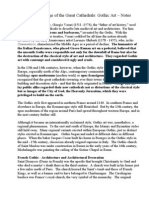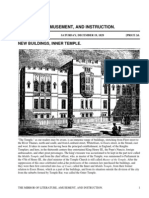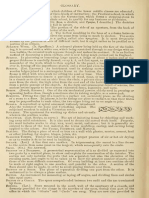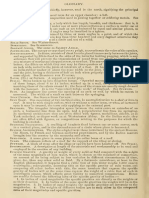Poixied.: Amongst Many
Poixied.: Amongst Many
Uploaded by
reacharunkCopyright:
Available Formats
Poixied.: Amongst Many
Poixied.: Amongst Many
Uploaded by
reacharunkOriginal Description:
Original Title
Copyright
Available Formats
Share this document
Did you find this document useful?
Is this content inappropriate?
Copyright:
Available Formats
Poixied.: Amongst Many
Poixied.: Amongst Many
Uploaded by
reacharunkCopyright:
Available Formats
Chap. IV.
POIXIED.
25fJ
Fig. n.AJI OF C.^TIIEnKAL, TUDELA.
in;; to S|)aiusii peculiarities: if the cajiilla ii.ai/i)?' or cliancel ever contiiined the clioir, the
transept must have lieen blocked up.
589. Amongst tlie works erected during tlie l;5tli century, there are so many whicli
exhibit loiiianesque work that this period miglit be said to be merely transitional, as
ilhistrated in the church of S. Pedro at Olite; the large church of the cistereian monastery
of Sta. Mai ia de Val de Dios,
l'il8, near Villaviciosa
;
and
the bridge 12.^0, rejjaired 14-19
at Orense in two sections, that
nearest the city having three
arches, each 36 ft, 8 ins, span
;
the other, 121:" ft, 6 ins. long,
and 16 ft. 6 ins, wide, having
seven arches, one of them being
82 ft. 8 ins. wide, and another
1 43 ft. 6 ins. sjian, and 1 24 ft.
6 ins. iiigh. Other works to
be noticed are the catliedral,
commenced II99, but con-
tinued very .slowly until 1258,
at Leon; it is dated l'2SO-40
by Mr. Street, in his work
above mentioned, who notices
that its con.struction, in a first-
pointed style, was continued
ui.til 130;i, that it failed, and
that the outside or jami)liglits
of the clearstoiy andtiiforium
were filled with masonry, and
that the south transept was
destroyed for reconstruction
about 1860: the fine cathedral,
1248-84, at Badajoz
;
and
the parish church (not a catludral) at Figueras near Gerona.
590. The succeeding great division of Gothic art is much more distinctly marked and
more uniform throughout Spain, whilst at the same time it is even less national and
pecidiar. There are very considerable remains of 14th century works, though, perhajJS, no
one grand and entire example. They are all extremely simi.ar in style, and more allied in
feeling and detail to German middle-pointed than to French. 'I'wo features deserve
recordfirst, the rei)rodi!Ction of the octagonal steejde, which was a most favourite type of
tlie romanesque builders; and secondly, the introduction of that grand innovation upon
old precedents, the gieat unbroken naves groined in stone and lighted fiom windows high
up in the walls.
591. As an example of the difficulty of classifying the buildings, it may be observed that
while the date of 1400 is usually given to tl.e church at Huesca, ascribed to Juan de
Olotzaga, it is probable that his name might be attached only to the great portal that is
romanesque, and cannot well be dated later than 1290 1300, It is pretty clear that it is
almost all a work of the 14th century. The unusually good example of middle-pointed
work afforded by the cloisters to the cathedral at Burgos shoidd date 1280-1350 accord-
ing to Mr. Street, rather than 1379-90, which is the jieriod at which they are said to
have been executed. The same author states that the round arches on clustered shafts of
the porch or cloister on the .south side of the church of S. Vicente at Avila might be sup-
posed to be not later than the 1 3tb century, were it not that a careful comparison of the
detail with other known detail proves pretty clearly that they cannot be earlier than about
the middle of the 14th century,
592. To the first half of the 14th century are due the west front of the cathedral at
Tarr.igona; the cloisters of the abbey at Veruela ; the east end,
131 '-'-46 (decidedly late
midale-pointed details) of the cathedral at Gerona; the hieronymite monastery of San
Bartolome, 1.330, at Lupiana by Diego Martinez, now private property ; and the church of
San Justo and San Pastor, 1345, at Barcelona, which is an unbroken chamber 138 ft. by
82 ft, 9 in., and 69 ft. higii. The widening, 1298-1329, of the cathedral, built 1058, at
Ba celona, seems to have been be^am in a first-pointed style, and to have been con-
tinued by Jayme Fabre, 1318-88, i.i a second-pointed style ;
the vaulting was fini-shud 1448.
593. Among the works dating in the middle of the 14th century, earlier or later, is the
church of Sta. iNIaiia de los Riyes. commonly called Sta. Maria del Pino, at Barcelona,
whicli .some date 1329-1413, but" others 1380-1413, This latter date is possibly that of its
lower bv Guillermo .\biell ; the church Mr. Street co:isiders must have been consecrated
You might also like
- Brunelleschi's Dome: How a Renaissance Genius Reinvented ArchitectureFrom EverandBrunelleschi's Dome: How a Renaissance Genius Reinvented ArchitectureRating: 4 out of 5 stars4/5 (548)
- Iiistolly Book: ArciiitectukeDocument1 pageIiistolly Book: ArciiitectukereacharunkNo ratings yet
- Many Humour Who The May Two The TheDocument1 pageMany Humour Who The May Two The ThereacharunkNo ratings yet
- Pointed,: GombaoDocument1 pagePointed,: GombaoreacharunkNo ratings yet
- History of We: Aiiciutec'IureDocument1 pageHistory of We: Aiiciutec'IurereacharunkNo ratings yet
- History of ArchitectureDocument1 pageHistory of ArchitecturereacharunkNo ratings yet
- Pointkl) .: FVL B 3PppppppplbbDocument1 pagePointkl) .: FVL B 3PppppppplbbreacharunkNo ratings yet
- ENDocument1 pageENreacharunkNo ratings yet
- Pointed,: Who May The When The King Onguet The TombDocument1 pagePointed,: Who May The When The King Onguet The TombreacharunkNo ratings yet
- Architectural Record Magazine AR-1897-10-12 - CompressedDocument116 pagesArchitectural Record Magazine AR-1897-10-12 - CompressedMarco MilazzoNo ratings yet
- ENDocument1 pageENreacharunkNo ratings yet
- Dame Dame: IiislollyDocument1 pageDame Dame: IiislollyreacharunkNo ratings yet
- Spain Report 1Document31 pagesSpain Report 1kNo ratings yet
- Retablo Renacentista GaliciaDocument17 pagesRetablo Renacentista GaliciacapelloNo ratings yet
- One We WeDocument1 pageOne We WereacharunkNo ratings yet
- Bell's Cathedrals: The Cathedral Church of Rochester: A Description of its Fabric and a Brief History of the Episcopal SeeFrom EverandBell's Cathedrals: The Cathedral Church of Rochester: A Description of its Fabric and a Brief History of the Episcopal SeeNo ratings yet
- Catedral de GironaDocument10 pagesCatedral de GironaQueralt Boixadé PalahíNo ratings yet
- Poin'Ied. Damede WhuhDocument1 pagePoin'Ied. Damede WhuhreacharunkNo ratings yet
- Dissertation Notre Dame de ParisDocument8 pagesDissertation Notre Dame de ParisPayForPaperUK100% (2)
- Renaissance Architecture (Europe, Russia)Document8 pagesRenaissance Architecture (Europe, Russia)Erick Mark Bataller Miranda0% (1)
- The Three Choirs: A Handbook to the Cathedrals of Gloucester, Hereford, and WorcesterFrom EverandThe Three Choirs: A Handbook to the Cathedrals of Gloucester, Hereford, and WorcesterNo ratings yet
- The Monastery of EscorialDocument78 pagesThe Monastery of Escorialpepex3333No ratings yet
- Ornamented: EnglishDocument1 pageOrnamented: EnglishreacharunkNo ratings yet
- Ilisiouv Aucihtkc'I'Iue.: T LFR ' NDocument1 pageIlisiouv Aucihtkc'I'Iue.: T LFR ' NreacharunkNo ratings yet
- History Of: AuciiriecDocument1 pageHistory Of: AuciiriecreacharunkNo ratings yet
- Magne: Tlie IiisDocument1 pageMagne: Tlie IiisreacharunkNo ratings yet
- Pointld.: KnownDocument1 pagePointld.: KnownreacharunkNo ratings yet
- Notre Dame Cathedral, France. Notre-Dame de Paris, Also Called Notre-Dame CathedralDocument18 pagesNotre Dame Cathedral, France. Notre-Dame de Paris, Also Called Notre-Dame CathedralGilsa CarcamoNo ratings yet
- Byzantine and Romanesque ArchitectureDocument479 pagesByzantine and Romanesque ArchitectureIftime Adnana100% (1)
- Arhitectura Bizantina Vol 2 - EnglDocument404 pagesArhitectura Bizantina Vol 2 - Englproteor_srlNo ratings yet
- Garki PDFDocument20 pagesGarki PDFNicole BeltranNo ratings yet
- HOA2 - Gothic Arch2Document6 pagesHOA2 - Gothic Arch2Diego AlmeidaNo ratings yet
- Or Aiicm en : RiistoiiyDocument1 pageOr Aiicm en : RiistoiiyreacharunkNo ratings yet
- CH 18 Gothic Art NotesDocument17 pagesCH 18 Gothic Art NotesVNN95100% (1)
- Bell's Cathedrals: The Cathedral Church of Lichfield: A Description of Its Fabric and A Brief History of the Espicopal SeeFrom EverandBell's Cathedrals: The Cathedral Church of Lichfield: A Description of Its Fabric and A Brief History of the Espicopal SeeNo ratings yet
- History Of: AilchitectulleDocument1 pageHistory Of: AilchitectullereacharunkNo ratings yet
- Church Furniture in Medieval English and Welsh Parish ChurchesDocument32 pagesChurch Furniture in Medieval English and Welsh Parish ChurchesAndrei ZamfirNo ratings yet
- Pointed.: New MadeDocument1 pagePointed.: New MadereacharunkNo ratings yet
- Tridente, Trevi & The Quirinale: Jewish Ghetto Isola TiberinaDocument1 pageTridente, Trevi & The Quirinale: Jewish Ghetto Isola TiberinagatoNo ratings yet
- Gothic ArchitectureDocument44 pagesGothic ArchitectureNeil Andre M. BorgadorNo ratings yet
- Now of LaDocument1 pageNow of LareacharunkNo ratings yet
- Construction Materials of Romanesque ArchitectureDocument9 pagesConstruction Materials of Romanesque ArchitectureScribdTranslationsNo ratings yet
- Origin and Development of Crown Post Roof. Fletcher and SpokesDocument32 pagesOrigin and Development of Crown Post Roof. Fletcher and Spokeslittleshell69No ratings yet
- Hadrians Serapeum in RomeDocument44 pagesHadrians Serapeum in RomeMarina MontesanoNo ratings yet
- G - Renaissance 61-67 RevisedDocument7 pagesG - Renaissance 61-67 RevisedYbette Anorico VillamarinNo ratings yet
- Gothic Architecture: 1. Describe in Detail About Reims CathedralDocument6 pagesGothic Architecture: 1. Describe in Detail About Reims CathedralNiharikaNo ratings yet
- Larnaca Pyrga VillageDocument7 pagesLarnaca Pyrga VillageelgrecosNo ratings yet
- Final Najud ...Document27 pagesFinal Najud ...vincent john chattoNo ratings yet
- Renaissance in FranceDocument23 pagesRenaissance in FranceNihal Singh VermaNo ratings yet
- Module 3Document33 pagesModule 3HebinNo ratings yet
- Lincoln: Hugh HughDocument1 pageLincoln: Hugh HughreacharunkNo ratings yet
- The Cathedral of Notre Dame de ParisDocument12 pagesThe Cathedral of Notre Dame de ParisCarlos Mendez PerezNo ratings yet
- The Mirror of Literature, Amusement, and Instruction Volume 14, No. 405, December 19, 1829 by VariousDocument38 pagesThe Mirror of Literature, Amusement, and Instruction Volume 14, No. 405, December 19, 1829 by VariousGutenberg.orgNo ratings yet
- Dialnet ElRetabloBarrocoEnSalamanca 234304Document34 pagesDialnet ElRetabloBarrocoEnSalamanca 234304Ana Teresita Berruecos Romero100% (1)
- German RomanesqueDocument20 pagesGerman Romanesquejaneeka_r0% (1)
- Prospekt BGF PDFDocument150 pagesProspekt BGF PDFreacharunkNo ratings yet
- General Terms and Conditions of The Pzu NNW (Personal Accident Insurance Pzu Edukacja InsuranceDocument19 pagesGeneral Terms and Conditions of The Pzu NNW (Personal Accident Insurance Pzu Edukacja InsurancereacharunkNo ratings yet
- En (1464)Document1 pageEn (1464)reacharunkNo ratings yet
- En (1386)Document1 pageEn (1386)reacharunkNo ratings yet
- En (1458)Document1 pageEn (1458)reacharunkNo ratings yet
- En (1459)Document1 pageEn (1459)reacharunkNo ratings yet
- En (1451)Document1 pageEn (1451)reacharunkNo ratings yet
- En (1383)Document1 pageEn (1383)reacharunkNo ratings yet
- Mate The: (Fig. - VrouldDocument1 pageMate The: (Fig. - VrouldreacharunkNo ratings yet
- And Rome.: in Front of The Prostyle Existed atDocument1 pageAnd Rome.: in Front of The Prostyle Existed atreacharunkNo ratings yet
- The The Jamb The Name Much The: Tlio CL - AssesDocument1 pageThe The Jamb The Name Much The: Tlio CL - AssesreacharunkNo ratings yet
- En (1382)Document1 pageEn (1382)reacharunkNo ratings yet
- En (1376)Document1 pageEn (1376)reacharunkNo ratings yet
- En (1374)Document1 pageEn (1374)reacharunkNo ratings yet
- En (1375)Document1 pageEn (1375)reacharunkNo ratings yet
- AP Human Geo Final Study GuideDocument9 pagesAP Human Geo Final Study GuideRenae BarnesNo ratings yet
- Prepared By: Rio Daine R. Abit Bsar 2B Date: March 25, 2021 Submitted To: Ar. Edison LongcopDocument1 pagePrepared By: Rio Daine R. Abit Bsar 2B Date: March 25, 2021 Submitted To: Ar. Edison LongcopFran MarkNo ratings yet
- The Different Ages of The Viking Gods - The Æsir, Vanir and JötnarDocument4 pagesThe Different Ages of The Viking Gods - The Æsir, Vanir and JötnarMarcus WiddleNo ratings yet
- View of Human Nature Different Views of Man 1. Natural and Transcendental ViewDocument22 pagesView of Human Nature Different Views of Man 1. Natural and Transcendental ViewLea Duzon BejarNo ratings yet
- BlasphemyDocument14 pagesBlasphemySluvietNo ratings yet
- Ashtar ChannelingDocument6 pagesAshtar ChannelingOwlbearNo ratings yet
- Chapitre 4 Stuart England and CommonweatlhDocument5 pagesChapitre 4 Stuart England and CommonweatlhLeïla PendragonNo ratings yet
- 2024 Oct Nov Tour Programme of Sringeri Jagadguru Sri Sannidhanam-1Document2 pages2024 Oct Nov Tour Programme of Sringeri Jagadguru Sri Sannidhanam-1sainayanpragadaNo ratings yet
- Ayog Assignmenta&bDocument2 pagesAyog Assignmenta&bMaurice Jane Eunice AyogNo ratings yet
- GFMS - Print Choice List DetailsDocument4 pagesGFMS - Print Choice List Detailsmanishaji856No ratings yet
- Conditionality - The Law of Cause and EffectDocument30 pagesConditionality - The Law of Cause and EffectKhala KhubaNo ratings yet
- Manhattan GRE 500 Essential WoDocument12 pagesManhattan GRE 500 Essential WoPhạm Quốc BảoNo ratings yet
- Reinventing Religions Syncretism and Transformation in Africa andDocument466 pagesReinventing Religions Syncretism and Transformation in Africa andromel azuajeNo ratings yet
- Sutra of The Merit and Virtue of The Past Vows of Medicine Master Vaidurya Light TathágataDocument20 pagesSutra of The Merit and Virtue of The Past Vows of Medicine Master Vaidurya Light TathágataRobert Falker100% (1)
- Aneñja Sappaya SuttaDocument5 pagesAneñja Sappaya SuttatanpausingNo ratings yet
- EpiphanyDocument2 pagesEpiphanyKimi Ali60% (5)
- Bhagavatam Tikas 03Document2,781 pagesBhagavatam Tikas 03YoSoy MajaNo ratings yet
- From Nahda To ExileDocument135 pagesFrom Nahda To ExileFabian Becerra GonzalezNo ratings yet
- Is the Quran Authentic?: (English - ي�ﻠ�إ)Document5 pagesIs the Quran Authentic?: (English - ي�ﻠ�إ)Larbi MegrousNo ratings yet
- Prayer Points For The GatheringDocument5 pagesPrayer Points For The GatheringJennibethNo ratings yet
- TITLE: "Simbahan Kong Mahal" (SMK) GENRE: Documentary Film TIME: 20-30 Minutes Channel: TV Maria Tentative Date of ShootingDocument2 pagesTITLE: "Simbahan Kong Mahal" (SMK) GENRE: Documentary Film TIME: 20-30 Minutes Channel: TV Maria Tentative Date of ShootingHazel LunaNo ratings yet
- Church of Finland - The Gay IssueDocument5 pagesChurch of Finland - The Gay IssueNathan HolzsterlNo ratings yet
- Soal STS Ganjil PAIDocument2 pagesSoal STS Ganjil PAIViydzikrillah ShibaNo ratings yet
- Strengths and Weaknesses of The Filipino Character - MARY-JOY-ANTONETTE-MATEODocument21 pagesStrengths and Weaknesses of The Filipino Character - MARY-JOY-ANTONETTE-MATEORey Ian TarigaNo ratings yet
- The Spanish Preface of The Gospel of BarnabasDocument2 pagesThe Spanish Preface of The Gospel of Barnabasعبد الخالق الهاشمي العلويNo ratings yet
- Religious Identity: in Praise of The Anonymity of Critical BelievingDocument15 pagesReligious Identity: in Praise of The Anonymity of Critical BelievingerodcruzNo ratings yet
- Dll-World Religion-Oct10-14-2022Document4 pagesDll-World Religion-Oct10-14-2022Manny DaleonNo ratings yet
- Chaos Cultists: Wargear OptionsDocument1 pageChaos Cultists: Wargear OptionsBen ZagamiNo ratings yet
- 5 Celts and TeutonsDocument5 pages5 Celts and TeutonsJulian GalvisNo ratings yet
- Sultanate HistoriographyDocument25 pagesSultanate HistoriographySudhansu panda100% (1)








































































































